
Oswald Achenbach stands as a pivotal figure in 19th-century German art, a master landscape painter whose canvases radiate the warmth and vibrancy of Italy, viewed through the lens of the Düsseldorf School and the broader Romantic movement. Born in Düsseldorf on February 2, 1827, and passing away in the same city on January 31, 1905, his life spanned a period of significant artistic evolution in Europe. He, alongside his elder brother, Andreas Achenbach, formed a cornerstone of German landscape painting, so much so that they were famously dubbed the "A and O" – the Alpha and Omega – signifying the breadth and perceived completeness of their contribution to the genre within their time. Oswald's particular genius lay in his ability to translate the sun-drenched vistas, bustling street scenes, and dramatic natural phenomena of Italy onto canvas with unparalleled luminosity and atmospheric depth.
His journey into the world of art began remarkably early. At the tender age of eight, in 1835, Oswald was admitted to the prestigious Kunstakademie Düsseldorf (Düsseldorf Art Academy). This was unusual, as the official minimum age for entry was twelve. This early start suggests a prodigious talent recognized even in childhood. His father, Hermann Achenbach, had a varied career, including stints as a brewer, innkeeper, and bookkeeper, indicating a family background perhaps not steeped in the fine arts but supportive of the young Oswald's inclinations. His mother was Christine Achenbach (née Zilch). Oswald was the fifth of ten children, growing up in a bustling household where artistic pursuits would soon become central, largely thanks to the success of both Oswald and Andreas.
Early Training and Departure from Academia
Despite his early entry, Oswald Achenbach's relationship with the formal structure of the Düsseldorf Academy was complex. He studied in the elementary class but reportedly grew dissatisfied with the academic constraints and the prevailing artistic doctrines, which he perhaps found too rigid or uninspiring for his burgeoning interest in capturing the direct experience of nature. Influential figures at the Academy during its peak included its director, Wilhelm von Schadow, who emphasized historical and religious painting, though landscape painting also flourished.
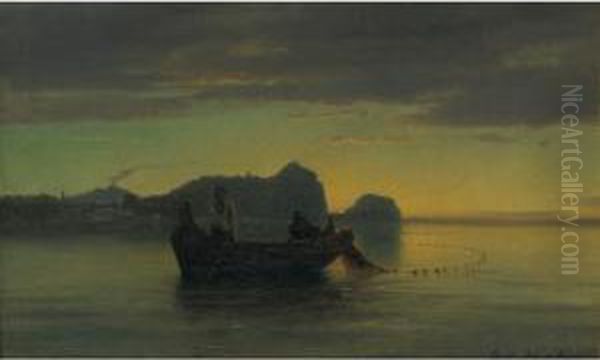
By 1841, Oswald had effectively left the main classes of the Academy. Seeking a more congenial and perhaps freer environment for artistic exchange and development, he became involved with several independent artist associations in Düsseldorf. These included the association "Malkasten" (Paintbox), known for its social gatherings and fostering of camaraderie among artists, and the "Künstlerverein" (Artists' Association). These groups provided alternative platforms for discussion, mutual support, and the development of artistic ideas outside the formal academy structure, reflecting a common trend among artists seeking greater independence during this period. He did complete the basic courses around 1845 but his path was already diverging towards a more independent study, particularly through travel.
The Düsseldorf School and Its Influence
To understand Oswald Achenbach's art, one must appreciate the context of the Düsseldorf School, where he received his initial training. Flourishing from the 1820s to the late 19th century, this school became one of the most influential art movements in Germany and internationally, particularly in Scandinavia and the United States. It was characterized by a high degree of technical finish, detailed realism often blended with Romantic or sentimental themes, and a strong emphasis on landscape painting.
Key figures associated with the school, besides the Achenbach brothers, included painters like Carl Friedrich Lessing, known for his historical and landscape paintings often imbued with a sense of melancholy or drama, and Johann Wilhelm Schirmer, who became a significant mentor figure, particularly in landscape. Schirmer, who later became the first director of the Karlsruhe art school, advocated for detailed nature studies combined with idealized compositions. His influence, emphasizing careful observation rendered with atmospheric sensitivity, can be discerned in the meticulous yet evocative landscapes of his students, including Oswald. Other notable artists linked to the school include Eduard Bendemann and later figures who carried its influence forward. The school fostered a generation of artists skilled in capturing nature's details while often infusing their scenes with narrative or emotional undertones.
The Lure of the South: Italian Journeys
A defining moment, or rather a series of defining moments, in Oswald Achenbach's artistic development came with his travels to Italy. The allure of Italy – its classical ruins, dramatic landscapes, unique quality of light, and vibrant folk life – had drawn Northern European artists south for centuries, part of a tradition often associated with the Grand Tour. For Achenbach, Italy became more than just a subject; it became the crucible in which his mature style was forged.
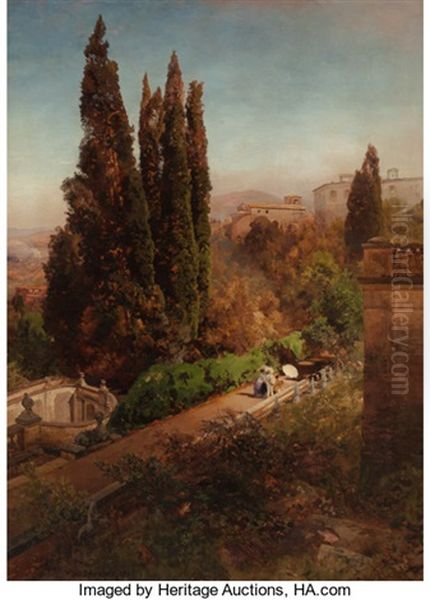
His first significant journey south began around 1843, when, at sixteen, he traveled through Upper Bavaria and North Tyrol, regions known for their Alpine beauty. During this trip, he produced numerous sketches, honing his observational skills and gathering raw material for future paintings. This was followed by his first proper trip to Italy in 1845, which included visits to Switzerland. This initial immersion in the Italian landscape, its light, and its culture proved transformative. He was captivated by the contrast between the cool, often somber tones of Northern Europe and the warm, luminous atmosphere of the Mediterranean.
Over his lifetime, Achenbach would return to Italy repeatedly – sources suggest as many as eight separate trips, with the last occurring in 1895. He explored various regions, but he developed a particular affinity for the area around Naples, including the Bay of Naples, the islands of Capri and Ischia, the looming presence of Mount Vesuvius, and the ancient ruins of Pompeii. He also spent considerable time in Rome and its environs (the Campagna), Florence, and other locations, capturing villas, gardens, festivals, and everyday scenes. These travels provided an inexhaustible source of inspiration, allowing him to move beyond the sometimes darker, more brooding landscapes typical of Northern Romanticism towards a style characterized by brightness, color, and atmospheric vibrancy. He was also influenced by the heroic Italian landscapes of painters like Carl Rottmann, known for his Greek cycle commissioned by King Ludwig I of Bavaria.
Mastering Light and Atmosphere: Achenbach's Artistic Style
Oswald Achenbach's mature style is a distinctive blend of Düsseldorf precision and Romantic sensibility, energized by his Italian experiences. His primary achievement lies in his masterful handling of light and color to evoke specific moods and times of day. He excelled at depicting the warm glow of the Italian sun, whether illuminating ancient ruins at sunset, casting dramatic shadows in narrow village streets, or reflecting off the azure waters of the Mediterranean.
His works often feature strong contrasts between light and shadow, creating a sense of depth and drama. Unlike the more symbolic or spiritual landscapes of contemporaries like Caspar David Friedrich, Achenbach's focus was more on the sensory experience of place, capturing the visual splendor and lively energy of Italy. While rooted in the detailed realism promoted by the Düsseldorf School, his brushwork could be surprisingly fluid and suggestive, particularly in rendering foliage, water, and atmospheric effects. This anticipates, in some ways, the looser techniques of later movements like Impressionism, although he remained fundamentally a Romantic Realist.
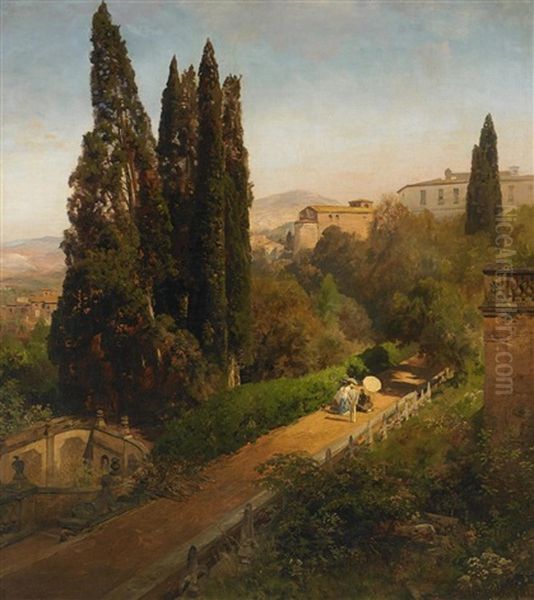
Color was paramount in his work. He employed a rich, often warm palette, using vibrant blues, greens, ochres, and reds to convey the intensity of the southern climate. He was particularly adept at capturing spectacular effects, such as the fiery glow of volcanic eruptions (a recurring theme with Vesuvius), the golden light of dusk, or the cool luminescence of moonlight. His compositions are carefully constructed, often employing a technique sometimes referred to as "dalev," where foreground elements like figures, architecture, or prominent trees anchor the scene and lead the viewer's eye into the expansive landscape beyond. These figures, often depicting local peasants, fishermen, or monks, add narrative interest and a sense of scale, grounding the sometimes idealized landscapes in human reality. His interest extended to historical architecture, meticulously rendering famous landmarks like the Trevi Fountain or Roman temples within their atmospheric settings.
Signature Works: Visions of Italy
Several paintings stand out as representative of Oswald Achenbach's oeuvre and encapsulate his artistic concerns. Eruption of Mount Vesuvius is a theme he revisited, capturing the terrifying sublimity of the volcano in action, contrasting the destructive power of nature with the beauty of the surrounding landscape, often illuminated by the dramatic, fiery light. These works showcase his ability to blend topographical accuracy with Romantic drama.
Sunset in the Bay of Naples (various versions exist) is another quintessential Achenbach subject. These paintings typically depict the iconic bay bathed in the warm, fading light of evening, with Vesuvius often visible in the distance. The interplay of light on the water, the silhouettes of boats, and the vibrant colors of the sky demonstrate his mastery of atmospheric effects and his deep affection for this particular locale.
View of Capri captures the rugged beauty and luminous atmosphere of the famous island. Achenbach skillfully renders the rocky coastline, the sparkling sea, and the characteristic vegetation under the brilliant Mediterranean sun. Similarly, his depictions of Rome, such as scenes featuring the Trevi Fountain or views of the Roman Forum, combine architectural detail with lively depictions of daily life and a palpable sense of place, often emphasizing the interplay of ancient history and contemporary existence. Other notable works include market scenes, depictions of Italian villas and gardens (like the Villa Torlonia or Villa d'Este), and coastal views from Sorrento or Amalfi, all rendered with his characteristic vibrancy and attention to light.
The Brothers Achenbach: A Symbiotic Relationship
The artistic careers of Oswald and his elder brother Andreas Achenbach (1815-1910) are inextricably linked. Andreas, also trained at the Düsseldorf Academy, was initially the more famous of the two. He specialized primarily in Northern European landscapes and dramatic seascapes, often depicting stormy coasts, Norwegian fjords, or Dutch canals. His style was characterized by a powerful realism and a focus on the sublime and sometimes harsh aspects of nature.
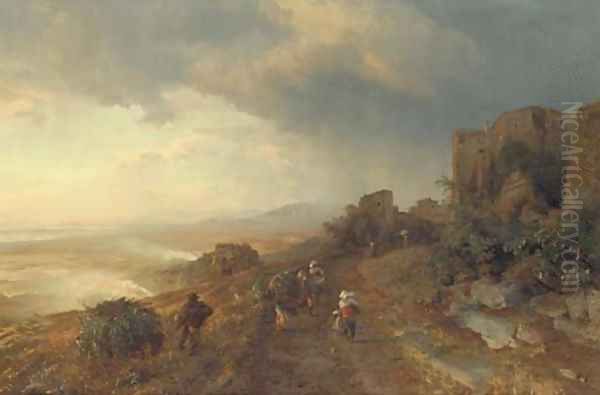
While both brothers shared a foundation in the Düsseldorf School's detailed realism, their paths diverged geographically and stylistically. Andreas became the master of the North, Oswald the master of the South. This thematic division led to the famous nickname "the A and O" (Alpha and Omega) of landscape painting, suggesting that together they encompassed the entire spectrum of the genre as perceived by their contemporaries. While they pursued different subjects, their shared background and mutual respect likely fostered a supportive, if perhaps implicitly competitive, dynamic. Their combined success significantly elevated the status of landscape painting within Germany and internationally.
Professor and Mentor at the Academy
Oswald Achenbach's contributions extended beyond his own artistic output. In 1863, he was appointed Professor of Landscape Painting at the Düsseldorf Art Academy, the very institution he had felt constrained by in his youth. He held this influential position until 1872, when he resigned. During his tenure, he played a significant role in shaping the next generation of landscape painters.
His teaching likely emphasized the importance of direct observation, sketching from nature (particularly during travels), and mastering the techniques of light and color that were central to his own work. He encouraged his students to develop their own responses to landscape, potentially moving beyond the stricter formulas sometimes associated with the Academy. Among his notable students were artists such as Gregor von Bochmann, known for his paintings of Estonian and Dutch coastal scenes, Albert Ernst, and Josef Will. Through his teaching, Achenbach helped to perpetuate and evolve the traditions of the Düsseldorf School, infusing it with the vibrancy he had discovered in Italy.
Recognition, Honors, and International Fame
Oswald Achenbach achieved considerable success and recognition during his lifetime. His paintings were highly sought after by collectors across Germany, Europe, and even in the United States, where the Düsseldorf School style found particular favor. He exhibited widely and received numerous accolades. A significant honor was the gold medal awarded at the prestigious Paris Salon in 1859, a mark of international esteem.
He was also granted honorary memberships in several leading art academies, including those in Berlin (1865), St. Petersburg, and Rotterdam. These honors reflected his standing as one of the leading landscape painters of his era. His works entered major public collections, including the Neue Pinakothek in Munich, the National Gallery in Berlin, and the Metropolitan Museum of Art in New York, ensuring his visibility and influence long after his death. His financial success allowed him a comfortable life and the means to undertake his extensive travels. In 1851, he married Julie Arnz, and they had three children.
Achenbach in the Context of 19th-Century Art
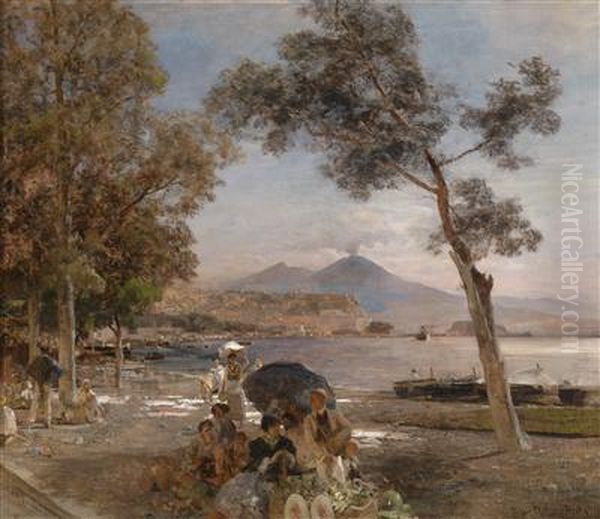
Placing Oswald Achenbach within the broader landscape of 19th-century European art reveals his position as a transitional figure. While firmly rooted in German Romanticism and the specific tenets of the Düsseldorf School, his emphasis on light, color, and capturing the fleeting effects of atmosphere connects him to developing trends towards Realism and even Impressionism.
Compared to the deeply symbolic and often melancholic landscapes of Caspar David Friedrich, Achenbach's work is more focused on the objective beauty and sensory experience of the natural world, though still imbued with Romantic drama. He shares with other German Romantics like Ludwig Richter or Carl Blechen an interest in rendering specific locales with feeling, but his technique, particularly his handling of light, often feels more modern.
His dedication to realistic detail aligns him with the broader Realist movement championed by artists like Gustave Courbet in France or Adolph Menzel in Germany, although Achenbach rarely engaged with the overt social commentary found in some Realist works. His fascination with light and atmospheric effects invites comparison with international contemporaries like J.M.W. Turner in Britain, though Achenbach's approach remained more grounded in topographical accuracy than Turner's increasingly abstract explorations of light and color. While not an Impressionist himself, his vibrant palette and attention to transient light effects arguably helped pave the way for the reception of Impressionism in Germany.
Later Life and Enduring Legacy
Oswald Achenbach remained active as a painter into his later years. His final trip to Italy in 1895 marked the end of his direct engagement with the landscapes that had so profoundly shaped his art. He passed away in his native Düsseldorf in 1905, just shy of his 78th birthday.
His legacy is multifaceted. He stands as one of the foremost exponents of the Düsseldorf School of landscape painting, particularly its more colorful, internationally oriented wing. He masterfully captured the essence of Italy for a Northern European audience, creating images that defined the perception of Italian landscapes for generations. His technical skill, especially in rendering light and atmosphere, was exceptional and influenced many subsequent artists. Alongside his brother Andreas, he dominated German landscape painting for decades, earning the enduring "A and O" moniker.
Today, Oswald Achenbach's paintings are appreciated for their technical brilliance, their evocative portrayal of Italy, and their position within the evolution of 19th-century landscape art. They offer a window onto a world where detailed observation met Romantic sensibility, resulting in works that are both topographically convincing and emotionally resonant, bathed in the unforgettable light of the South. His work continues to be exhibited and studied, securing his place as a significant master of German Romantic landscape painting.